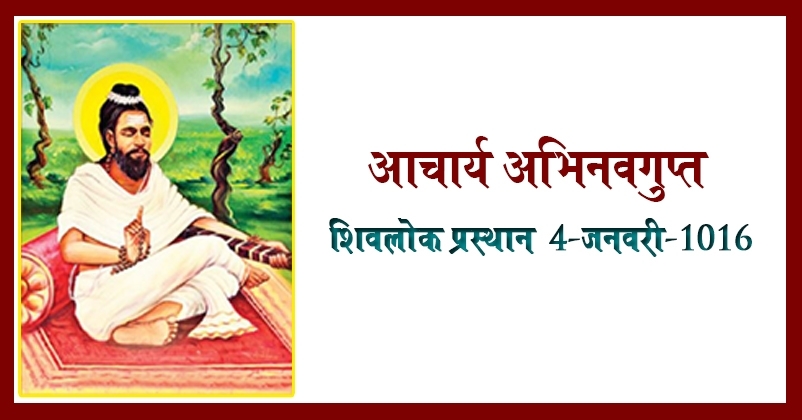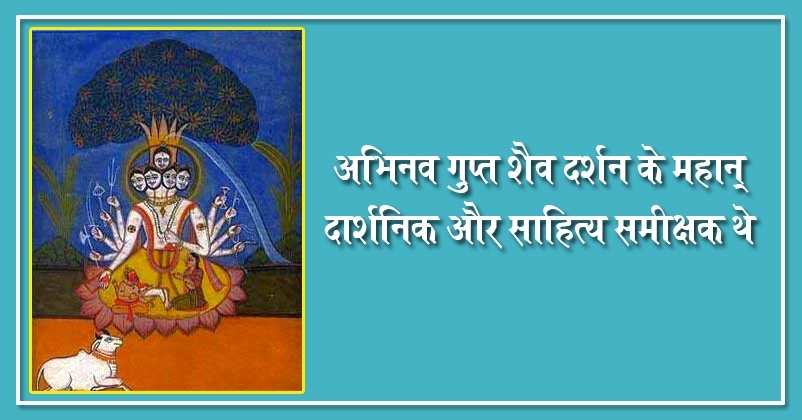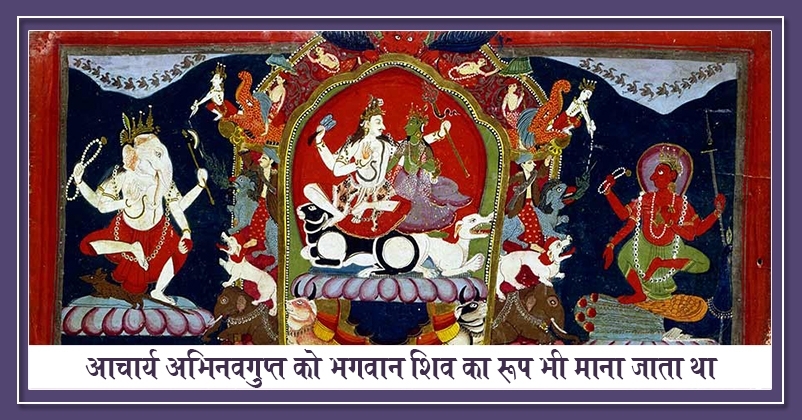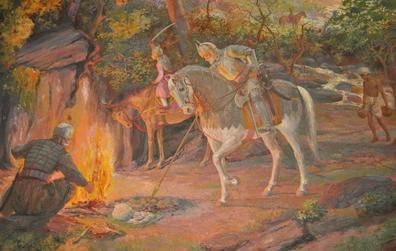महानतम दार्शनिक आचार्य अभिनवगुप्त की भूमि है कश्मीर, यहां की सनातन परंपरा को पहचानिए, जड़ों को जानिए.....
| 08-अगस्त-2019 |

सतातन परम्परा के रत्नगर्भा कश्मीर ने भारत और विश्व को असंख्य अनमोल रत्न दिये हैं, जिन्होंने अपने आध्यात्मिक ज्ञान, साधना की पराकाष्ठा से समस्त विश्व को नयी दिशा दिखायी। कश्मीर में अनेक मत-पंथ जन्मे, फले-फूले। तात्कालीन सामाजिक आध्यात्मिक व्यवस्था में कई बार बदलाव हुए, लेकिन नये बदलाव ने पुराने के खारिज नहीं किया। आचार्य अभिनवगुप्त इसी श्रंखला की सबसे महत्वपूर्ण कड़ी हैं। आचार्य अभिनवगुप्त का जन्म कश्मीर में 10 वीं शताब्दी के मध्य भाग में हुआ था (लगभग 950 ई. - 960 ई. के बीच)। इनका कुल अपनी विद्या, विद्वता तथा तांत्रिक साधना के लिए कश्मीर में नितांत प्रख्यात था। इनके पितामह का नाम था वराहगुप्त तथा पिता का नरसिंहगुप्त जो लोगों में "चुखुल" या "चुखुलक" के घरेलू नाम से भी प्रसिद्ध थे। अभिनव में ज्ञान की इतनी तीव्र पिपासा थी कि इसकी तृप्ति के लिए इन्होंने कश्मीर के बाहर जालंधर की यात्रा की और वहाँ अर्धत्र्यंबक मत के प्रधान आचार्य शंभुनाथ से कौलिक मत के सिद्धांतों और उपासनातत्वों का प्रगाढ़ अनुशीलन किया। इन्होंने अपने गुरुओं के नाम ही नहीं दिए हैं, प्रत्युत उनसे अधीत शास्त्रों का भी निर्देश किया है। इन्होंने व्याकरण का अध्ययन अपने पिता नरसिंहगुप्त से, ब्रह्मविद्या का भूतिराज से, क्रम और त्रिक्दर्शनों का लक्ष्मण गुप्त से, ध्वनि का भट्टेंद्रराज से तथा नाट्यशास्त्र का अध्ययन भट्ट तोत (या तौत) से किया। इनके गुरुओं की संख्या बीस तक पहुँचती है।
भारत की ज्ञान-परंपरा में आचार्य अभिनवगुप्त एवं कश्मीर की स्थिति को एक ‘संगम-तीर्थ’ के रूपक से बताया जा सकता है। जैसे कश्मीर (शारदा देश) संपूर्ण भारत का ‘सर्वज्ञ पीठ’ है, वैसे ही आचार्य अभिनवगुप्त संपूर्ण भारतवर्ष की सभी ज्ञान-विधाओं एवं साधना की परंपराओं के सर्वोपरि समादृत आचार्य हैं। काश्मीर केवल शैवदर्शन की ही नहीं, अपितु बौद्ध, मीमांसक, नैयायिक, सिद्ध, तांत्रिक, सूफी आदि परंपराओं का भी संगम रहा है। आचार्य अभिनवगुप्त अद्वैत आगम एवं प्रत्यभिज्ञा-दर्शन के प्रतिनिधि आचार्य तो हैं ही, साथ ही उनमें एक से अधिक ज्ञान-विधाओं का भी समाहार है।
भारतीय ज्ञान-दर्शन में यदि कहीं कोई ग्रंथि है, कोई पूर्व पक्ष और सिद्धांत पक्ष का निष्कर्षविहीन वाद चला आ रहा है और यदि किसी ऐसे विषय पर आचार्य अभिनवगुप्त ने अपना मत प्रस्तुत किया हो तो वह ‘वाद’ स्वीकार करने योग्य निर्णय को प्राप्त कर लेता है। उदाहरण के लिए साहित्य में उनकी भरतमुनिकृत रस-सूत्र की व्याख्या देखी जा सकती है जिसे ‘अभिव्यक्तिवाद’ के नाम से जाना जाता है। भारतीय ज्ञान एवं साधना की अनेक धाराएँ अभिनवगुप्तपादाचार्य के विराट् व्यक्तित्व में आ मिलती हैं और एक सशक्त धारा के रूप में आगे चल पड़ती है।
दार्शनिक परम्परा के कुल में जन्मे थे आचार्य अभिनवगुप्त

आचार्य अभिनवगुप्त के पूर्वज अत्रिगुप्त (8वीं शताब्दी) कन्नौज प्रांत के निवासी थे। यह समय राजा यशोवर्मन का था। अत्रिगुप्त कई शास्त्रों के विद्वान थे और शैवशासन पर उनका विशेष अधिकार था। कश्मीर नरेश ललितादित्य ने 740 ई. जब कान्यकुब्ज प्रदेश को जीतकर कश्मीर के अंतर्गत मिला लिया तो उन्होंने अत्रिगुप्त से कश्मीर में चलकर निवास की प्रार्थना की। वितस्ता (झेलम) के तट पर भगवान शितांशुमौलि (शिव) के मंदिर के सम्मुख एक विशाल भवन अत्रिगुप्त के लिये निर्मित कराया गया। इसी यशस्वी कुल में अभिनवगुप्त का जन्म लगभग 200 वर्ष बाद (950 ई.) हुआ। उनके पिता का नाम नरसिंहगुप्त तथा माता का नाम विमला था जिन्हें अपने ग्रंथों में वे आदर और श्रद्धा से स्मरण करते हुए ‘विमलकला’ कहते हैं।
भगवान शिव के अवतार कहे जाते हैं आचार्य अभिनवगुप्त
भगवान् पतंजलि की तरह आचार्य अभिनवगुप्त भी शेषावतार कहे जाते हैं। शेषनाग ज्ञान-संस्कृति के रक्षक हैं। अभिनवगुप्त के ग्रंथ तंत्रालोक के टीकाकार आचार्य जयरथ ने उन्हें ‘योगिनीभू’ कहा है। इस रूप में तो वे स्वयं ही शिव के अवतार के रूप में प्रतिष्ठित हैं।
मधुराज योगिन के शब्दों में आचार्य अभिनवगुप्त का शब्दचित्र
प्रभावान दक्षिणमूर्ति (आचार्य अभिनवगुप्त), जोकि साक्षात शिव के अवतार हैं, हमारी रक्षा करें। अपनी करूणा के कारण ही वो नया शरीर धारण कर कश्मीर में अवतरित हुए हैं। वे सुनहरे अंगूरों की वाटिका के बीच एक मण्डप में विराजमान हैं, जो रत्नजड़ित है और जिसके भीतर सुंदर कलाकृतियां लगी हुई हैं। मंडप के चारों और फूलों, अगरबत्तियों और प्रज्जवलित दीपों की सुगंध फैली हुई है। चारों ओर योगिनियां, ज्ञानीजनों औऱ चामात्कारिक शक्तिवाले सिद्धों की भीड़ है। अभिनवगुप्त आध्यात्मिक आनंद की अवस्था में हैं। उनकी आँखों की पुतलियां उल्लास के कारण नाच रही हैं। उनके माथे के बीच भस्म का तिलक लगा लगा है। उनके एक कान में रूद्राक्ष लटक रहा है और उनके सुंदर लंबे केश फूलों की माला से पीछे की ओर बंधें हुए हैं। उनकी दाढ़ी लंबी है और तन का रंग स्वर्णिम है। उनकी ग्रीवा चमकदार यक्षपंक भस्म के कारण काली है। ग्रीवा से उनका उपवीत नीचे की ओर लटक रहा है। वे चंद्र-किरणों की भांति धवल रेशमी वस्त्र पहने योगासन में बैठे हैं, जिसे वीरमुद्रा कहते हैं। उनका एक हाथ घुटने पर है, हाथ में माला है। ऐसी मुद्रा में हैं जो उनकी परम चैतन्य की अनुभूति का प्रतीक हैं। कमल-जैसे सुंदर दूसरे हाथ की उंगलियों से वो वीणा के तार बजा रहे हैं।
आचार्य अभिनवगुप्त के ज्ञान की प्रामाणिकता इस संदर्भ में है कि उन्होंने अपने काल के मूर्धन्य आचार्यों-गुरुओं से ज्ञान की कई विधाओं में शिक्षा-दीक्षा ली थी। उनके पितृवर श्री नरसिंहगुप्त उनके व्याकरण के गुरु थे। इसी प्रकार लक्ष्मणगुप्त प्रत्यभिज्ञाशास्त्र के तथा शंभुनाथ (जालंधर पीठ) उनके कौल-संप्रदाय के साधना के गुरु थे। उन्होंने अपने ग्रंथों में अपने नौ गुरुओं का सादर उल्लेख किया है। भारतवर्ष के किसी एक आचार्य में विविध ज्ञान विधाओं का समाहार मिलना दुर्लभ है। यही स्थिति शारदा क्षेत्र कश्मीर की भी है। इस अकेले क्षेत्र से जितने आचार्य हुए हैं उतने देश के किसी अन्य क्षेत्र से नहीं हुए।

जैसी गौरवशाली आचार्य अभिनवगुप्त की गुरु परम्परा रही है वैसी ही उनकी शिष्य परंपरा भी है। उनके प्रमुख शिष्यों में क्षेमराज , क्षेमेन्द्र एवं मधुराजयोगी हैं। यही परंपरा सुभटदत्त (12वीं शताब्दी) जयरथ, शोभाकर-गुप्त, महेश्वरानन्द (12वीं शताब्दी), भास्कर कंठ (18वीं शताब्दी) प्रभृति आचार्यों से होती हुई स्वामी लक्ष्मण जू तक आती है। दुर्भाग्यवश यह विशद एवं अमूल्य ज्ञान राशि इतिहास के घटनाक्रमों में धीरे-धीरे हाशिये पर चली गई। यह केवल काश्मीर के घटनाक्रमों के कारण नहीं हुआ।
14वीं शताब्दी के अद्वैत वेदान्त के आचार्य सायण -माधव (माधवाचार्य) ने अपने सुप्रसिद्ध ग्रन्थ ‘सर्वदर्शन संग्रह’ में सोलह दार्शनिक परम्पराओं का विवेचन शांकर-वेदांत की दृष्टि से किया है। आधुनिक विश्वविद्यालयी पद्धति केवल षड्दर्शन तक ही भारतीय दर्शन का विस्तार मानती है और इन्हे ही आस्तिक दर्शन और नास्तिक दर्शन के द्वन्द्व-युद्ध के रूप में प्रस्तुत करती है। आगमोक्त दार्शनिक परम्पराएँ जिनमें शैव, शाक्त, पांचरात्र आदि हैं, वे कहीं विस्मृत होते चले गए।
आचार्य अभिनवगुप्त ने अपने सुदीर्घ जीवन को केवल तीन महत् लक्ष्यों के लिए समर्पित कर दिया- शिवभक्ति, ग्रंथ निर्माण एवं अध्यापन। उनके द्वारा रचित 42 ग्रंथ बताए जाते हैं, इनमें से केवल 20-22 ही उपलब्ध हो पाए हैं। सौ से अधिक ऐसे आगम ग्रंथ हैं, जिनका उल्लेख-उद्धरण उनके ग्रंथों में तो है, लेकिन अब वे लुप्तप्राय हैं। अभिनवगुप्त के ग्रंथों की पांडुलिपियां दक्षिण में प्राप्त होती रही हैं, विशेषकर केरल राज्य में। उनके ग्रंथ संपूर्ण प्राचीन भारतवर्ष में आदर के साथ पढ़ाये जाते रहे थे। 70 वर्ष की अवस्था में जब उन्होंने महाप्रयाण किया तब उनके 10 हजार शिष्य कश्मीर में थे।
4 जनवरी 1016 को श्रीनगर से गुलमर्ग जाने वाले मार्ग पर स्थित भैरव गुफा में प्रवेश कर उन्होंने सशरीर महाप्रयाण किया।
आचार्य अभिनवगुप्त द्वारा रचित ग्रंथ
अभिनवगुप्त तंत्रशास्त्र, साहित्य और दर्शन के प्रौढ़ आचार्य थे और इन तीनों विषयों पर इन्होंने 50 से ऊपर मौलिक ग्रंथों, टीकाओं तथा स्तोत्रों का निर्माण किया है। अभिरुचि के आधार पर इनका सुदीर्घ जीवन तीन कालविभागों में विभक्त किया जा सकता है:
1. तान्त्रिक काल - जीवन के आरंभ में अभिनवगुप्त ने तंत्रशास्त्रों का गहन अनुशीलन किया तथा उपलब्ध प्राचीन तंत्रग्रंथों पर इन्होंने अद्धैतपरक व्याख्याएँ लिखकर लोगों में व्याप्त भ्रांत सिद्धांतों का सफल निराकरण किया। क्रम, त्रिक तथा कुल तंत्रों का अभिनव ने क्रमश: अध्ययन कर तद्विषयक ग्रंथों का निर्माण इसी क्रम से संपन्न किया। इस युग की प्रधान रचनाएँ ये हैं -- बोधपंचदशिका, मालिनीविजय कार्तिक, परात्रिंशिकाविवरण, तन्त्रालोक, तन्त्रसार, तंत्रोच्चय, तंत्रोवटधानिका। तंत्रालोकत्रिक तथा कुल तंत्रों का विशाल विश्वकोश ही है जिसमें तंत्रशास्त्र के सिद्धांतों, प्रक्रियाओं तथा तत्संबद्ध नाना मतों का पूर्ण, प्रामाणिक तथा प्रांजल विवेचन प्रस्तुत किया गया है। यह 37 परिच्छेदों में विभक्त विराट् ग्रंथराज है जिसमें बंध का कारण, मोक्षविषक नाना मत, प्रपंच का अभिव्यक्ति प्रकार तथा सत्ता, परमार्थ के साधक उपाय, मोक्ष के स्वरूप, शैवाचार की विविध प्रक्रिया आदि विषयों का सुंदर प्रामाणिक विवरण देकर अभिनव ने तंत्र के गंभीर तत्वों को वस्तुत: आलोकित कर दिया है। अंतिम तीनों ग्रंथ इसी के क्रमश: संक्षिप्त रूप हैं जिनमें संक्षेप पूर्वापेक्षया ह्रस्व होता गया है।
2. आलंकारिक काल - अलंकारग्रंथों का अनुशीलन तथा प्रणयन इस काल की विशिष्टता है। इस युग से संबद्ध तीन प्रौढ़ रचनाओं का परिचय प्राप्त है - काव्य-कौतुक-विवरण, ध्वन्यालोकलोचन तथा अभिनवभारती। काव्यकौतुक अभिनव के नाट्यशास्त्र के गुरु भट्टतौत की अनुपलब्ध प्रख्यात कृति है जिसपर इनका "विवरण" अन्यत्र संकेतित ही है, उपलब्ध नहीं। लोचन, आनन्दवर्धन के "ध्वन्यालोक" का प्रौढ़ व्याख्यानग्रंथ है तथा अभिनवभारती, भरत मुनि के नाट्यशास्त्र के पूर्ण ग्रंथ की पांडित्यपूर्ण प्रमेयबहुल व्याख्या है। यह नाट्यशास्त्र की एकमात्र टीका है।
3. दार्शनिक काल - अभिनवगुप्त के जीवन में यह काल उनके पांडित्य की प्रौढ़ि और उत्कर्ष का युग है। परमत का तर्कपद्धति से खंडन और स्वमत का प्रौढ़ प्रतिपादन इस काल की विशिष्टता है। इस काल की प्रौढ़ प्रतिपादन इस काल की विशिष्टता है। इस काल की प्रौढ़ रचनाओं में ये नितांत प्रसिद्ध हैं---भगवद्गीतार्थसंग्रह, परमार्थसार, ईश्वर-प्रत्यभिज्ञा-विमर्शिणी तथा ईश्वर-प्रत्यभिज्ञा-विवृति-विमर्शिणी। अंतिम दोनें ग्रंथ अभिनवगुप्त के प्रौढ़ पांडित्य के निकषग्रावा हैं। ये उत्पलाचार्य द्वारा रचित "ईश्वरप्रत्यभज्ञ" के व्याख्यान हैं। पहले में तो केवल कारिकाओं की व्याख्या और दूसरे उत्पल की ही स्वोपज्ञ वृत्ति (आजकल अनुपलब्ध) "विवृति" की प्रांजल टीका है। प्राचीन गणनानुसार चार सहस्र श्लोकों से संपन्न होने के कारण पहली टीका "चतु:सहस्री" (लघ्वी) तथा दूसरी "अष्टादशसहस्री" (अथवा बृहती) के नाम से भी प्रसिद्ध है जिनमें टीका अब तक अप्रकाशित ही है।
आज भी प्रासंगिक हैं आचार्य अभिनवगुप्त
अभिनवगुप्त के युग के जैसी समस्यायें और चुनौतियां समाज के सामने थी, वैसी ही चुनौतियां बौद्धिक और सामजिक स्तर पर आज भी हमारे सामने हैं। इसी आचार्य अभिनवगुप्त का दार्शनिक चिंतन जितना प्रासंगिक 10वीं-11वीं सदी में था, वैसा ही आज भी है। मतलब आज जम्मू कश्मीर के बारे में बहस और चिंतन का विषय बदलने का आवश्यकता है। प्राचीन शारदाखण्ड भारत का ऐसा सांस्कृतिक केंद्र रहा है जिसका स्पंदन और असर देश के सूदूर प्रांत में भी महसूस किया जाता रहा है। इस सांस्कृतिक, बौद्धिक और दार्शनिक प्रयोगशाला के निर्माण में देश के हर क्षेत्र के मनीषियों और विद्वानों का योगदान रहा है, चाहे वो दक्षिण के केरल औऱ कर्नाटक के हों या पूर्व में असम या बंगाल के या फिर गंगा-यमुना की घाटियों से आयें हों। इसी प्रकार देश का शायद ही कोई ऐसा क्षेत्र होगा जहां शारदाखण्ड कश्मीर की प्रतिभा का प्रतिबिम्बित न हुआ हो। जब अभिनवगुप्त प्रत्यभिज्ञा पर बल देते हैं जो जीव के अंतर में विद्यमान शिव की पहचान की बात करते हैं। लेकिन आज हमारे सामने जन-जन के मन में बसे विराट राष्ट्र की प्रत्यभिज्ञा की बड़ी चुनौती है जिसका समाधान आचार्य अभिनवगुप्त के बताये मार्ग पर ही है।
sabhar

